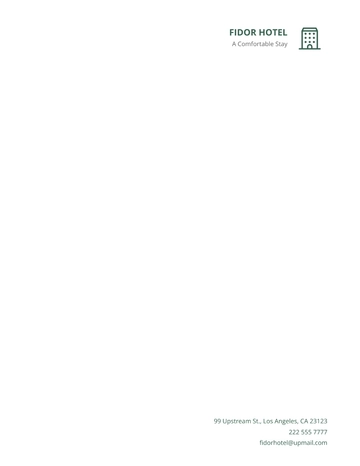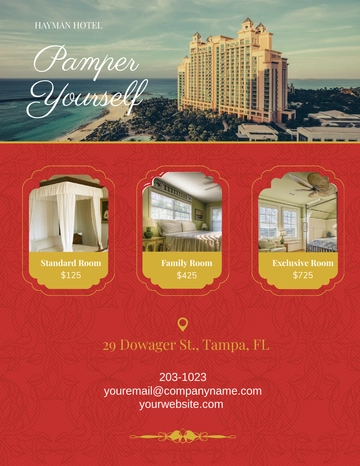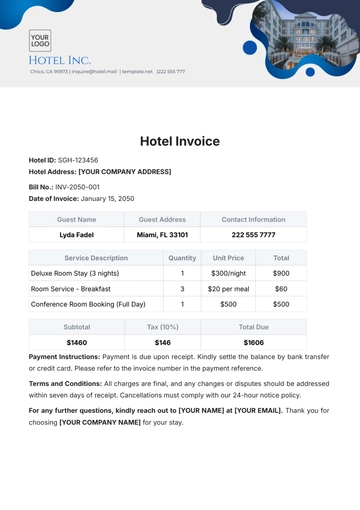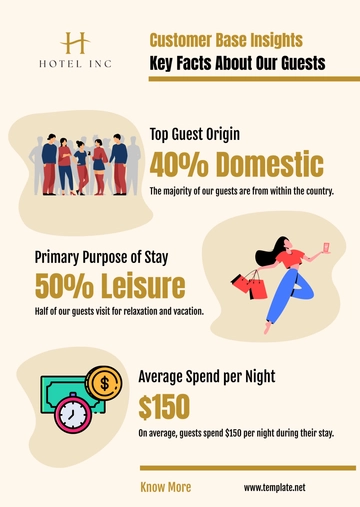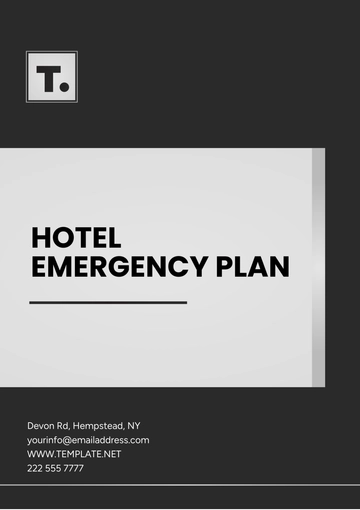Free Hotel Growth Strategy

I. Introduction
The purpose of this document is to outline the comprehensive growth strategy plan for [Your Company Name]. Our aim is to identify key areas for expansion, enhance operational efficiency, and leverage market opportunities to ensure sustainable growth in the competitive hospitality industry. This strategy will serve as a roadmap for achieving our long-term goals and objectives, helping us navigate the evolving market landscape.
In an industry where customer expectations are continuously rising, it is imperative to adapt and innovate. Our growth strategy focuses on increasing market share, improving guest satisfaction, and expanding our portfolio through strategic acquisitions and partnerships. By analyzing current market trends and internal performance metrics, we can better position ourselves to capitalize on emerging opportunities and mitigate potential risks.
Through this document, we will explore various components of our growth strategy, including market analysis, customer experience enhancement, operational efficiency, technological innovation, and financial planning. It provides detailed insights and actionable plans to drive our growth initiatives forward, ensuring that we remain at the forefront of the hospitality industry.
II. Market Analysis
A. Current Market Position
The following table presents an analysis of our current market position, highlighting key metrics such as occupancy rates, average daily rate (ADR), and revenue per available room (RevPAR) for the years 2054 to 2058:
Metric | 2054 | 2055 | 2056 | 2057 | 2058 |
|---|---|---|---|---|---|
Occupancy Rate | 78% | 80% | 82% | 84% | 85% |
ADR | $220 | $230 | $240 | $250 | $260 |
RevPAR | $172 | $184 | $197 | $210 | $221 |
The current market position analysis reveals an upward trend in occupancy rates over the next five years. This steady increase indicates growing demand for our hotel services, suggesting effective marketing and customer satisfaction strategies. Additionally, the Average Daily Rate (ADR) shows a consistent rise, reflecting our ability to charge higher rates due to enhanced service quality and brand reputation.
Moreover, the Revenue Per Available Room (RevPAR) also exhibits growth, aligning with the improvements in occupancy rates and ADR. This metric is crucial as it combines both occupancy and pricing strategies to give a comprehensive view of our revenue performance. Our continuous focus on enhancing guest experiences and optimizing pricing strategies contributes to these positive trends.
Further insights into these metrics highlight the importance of maintaining this growth trajectory. Sustaining high occupancy rates ensures a stable revenue stream, while increasing ADR allows us to capitalize on our brand strength. RevPAR, being a critical indicator of overall financial health, underscores the necessity of balancing occupancy and pricing to maximize revenue.
B. Competitive Analysis
The following table compares our performance metrics with those of key competitors:
Metric | [Your Company Name] | Lux Hotels | Elegance Suites | Prime Lodging |
|---|---|---|---|---|
Occupancy Rate | 80% | 78% | 76% | 75% |
ADR | $230 | $225 | $220 | $215 |
RevPAR | $184 | $176 | $167 | $161 |
The competitive analysis highlights that [Your Company Name] holds a favorable position in the market with higher occupancy rates and ADR compared to our key competitors. Lux Hotels, while competitive, shows slightly lower metrics, indicating room for improvement in their market strategy. Elegance Suites and Prime Lodging also lag behind, particularly in RevPAR, suggesting they may struggle with either occupancy, pricing strategies, or both.
In terms of occupancy rate, our superior performance reflects our ability to attract and retain guests effectively. This success can be attributed to our targeted marketing campaigns, superior guest services, and strategic location choices. Higher ADR demonstrates our capacity to command premium pricing, likely due to the quality of our facilities and the overall guest experience we offer.
These insights emphasize the importance of maintaining our competitive edge through continuous innovation and customer satisfaction initiatives. As we move forward, it will be crucial to monitor competitor strategies and market trends closely to ensure that we remain ahead in the industry.
III. Customer Experience Enhancement
A. Guest Satisfaction Initiatives
To further enhance customer experience, we plan to implement a series of initiatives aimed at increasing guest satisfaction. These initiatives will focus on personalized services, improved amenities, and seamless guest interactions.
Personalized Services: By leveraging customer data, we will offer tailored experiences that cater to individual preferences. This includes personalized room settings, special offers, and customized itineraries.
Improved Amenities: We will upgrade our facilities to include state-of-the-art fitness centers, luxury spa services, and enhanced dining options. This will ensure that guests have access to top-tier amenities throughout their stay.
Seamless Interactions: Implementing advanced technology solutions such as mobile check-ins, smart room controls, and AI-powered concierge services will streamline guest interactions and enhance convenience.
Loyalty Programs: Enhancing our loyalty programs with more benefits and exclusive offers will encourage repeat business and strengthen customer loyalty.
Feedback Mechanisms: Establishing robust feedback mechanisms will allow us to continuously monitor and improve our services based on guest input.
B. Staff Training Programs
Our staff training programs are designed to equip our employees with the skills and knowledge necessary to deliver exceptional service.
Customer Service Excellence: Training programs focused on customer service excellence will ensure that our staff can meet and exceed guest expectations consistently.
Cultural Sensitivity Training: As we cater to a diverse clientele, cultural sensitivity training will help our staff provide inclusive and respectful service to all guests.
Technical Skills: Training in the latest hospitality technologies will enable our staff to utilize tools and systems efficiently, enhancing operational efficiency.
Crisis Management: Preparing our staff for potential crises through comprehensive training programs will ensure that they can handle emergencies effectively.
IV. Operational Efficiency
A. Streamlined Processes
To enhance operational efficiency, we will streamline various processes within the hotel.
Automated Systems: Implementing automated systems for reservations, billing, and inventory management will reduce manual errors and improve accuracy.
Energy Management: Utilizing energy-efficient systems and practices will lower operational costs and promote sustainability.
Supply Chain Optimization: Optimizing our supply chain processes will ensure timely delivery of goods and reduce wastage.
Maintenance Schedules: Establishing regular maintenance schedules for our facilities will prevent unexpected breakdowns and extend the lifespan of our assets.
B. Cost Reduction Strategies
The following table outlines our cost reduction strategies, focusing on different areas of operation:
Area | Strategy | Expected Savings |
|---|---|---|
Energy Consumption | Implementing LED lighting | $50,000 |
Housekeeping | Adopting eco-friendly cleaning supplies | $30,000 |
Food and Beverage | Streamlining menu items | $25,000 |
Staffing | Cross-training employees | $40,000 |
Cost reduction strategies play a crucial role in enhancing our profitability without compromising on service quality. By focusing on areas such as energy consumption, housekeeping, food and beverage, and staffing, we can achieve significant savings. For instance, adopting LED lighting not only reduces energy costs but also aligns with our sustainability goals.
Streamlining housekeeping with eco-friendly cleaning supplies not only saves costs but also appeals to environmentally conscious guests. Similarly, optimizing our food and beverage offerings can reduce waste and improve menu efficiency. Cross-training employees ensures operational flexibility and reduces the need for additional staffing during peak periods.
The successful implementation of these strategies requires continuous monitoring and adjustments based on performance metrics. It is important to ensure that cost-saving measures do not negatively impact guest satisfaction, as maintaining high service standards remains a top priority.
V. Technological Innovation
A. Digital Transformation
Our digital transformation strategy focuses on integrating advanced technologies to enhance both guest experience and operational efficiency.
Smart Room Technology: Implementing smart room technology, including voice-activated controls and personalized settings, will elevate the guest experience.
AI and Machine Learning: Utilizing AI and machine learning for predictive analytics will help us anticipate guest needs and personalize services.
Blockchain for Transactions: Incorporating blockchain technology for secure and transparent transactions will enhance trust and reduce fraud.
Mobile App Development: Developing a comprehensive mobile app will allow guests to manage their bookings, access hotel services, and provide feedback seamlessly.
Cybersecurity Measures: Strengthening our cybersecurity measures will protect sensitive guest information and ensure data integrity.
B. Data Analytics
The following table presents the areas where data analytics will be implemented to drive decision-making and improve operations:
Area | Application | Expected Impact |
|---|---|---|
Marketing | Customer segmentation | Increased campaign ROI |
Operations | Predictive maintenance | Reduced downtime |
Revenue Management | Dynamic pricing models | Maximized revenue |
Customer Service | Sentiment analysis | Enhanced satisfaction |
Implementing data analytics across various areas of operation enables us to make informed decisions based on real-time data. For example, customer segmentation in marketing allows us to tailor campaigns to specific audience groups, increasing the return on investment. Predictive maintenance in operations reduces downtime by identifying potential issues before they escalate.
Dynamic pricing models in revenue management optimize room rates based on demand patterns, maximizing revenue. Sentiment analysis in customer service provides insights into guest satisfaction, allowing us to address issues proactively and enhance overall experience.
Leveraging data analytics is essential for staying competitive in the hospitality industry. By harnessing the power of data, we can drive efficiency, improve guest satisfaction, and ultimately achieve our growth objectives.
VI. Financial Planning
A. Budget Allocation
The following table outlines our budget allocation for key growth initiatives over the next five years:
Initiative | 2054 | 2055 | 2056 | 2057 | 2058 |
|---|---|---|---|---|---|
Marketing and Advertising | $1,000,000 | $1,100,000 | $1,200,000 | $1,300,000 | $1,400,000 |
Technology Investments | $800,000 | $850,000 | $900,000 | $950,000 | $1,000,000 |
Facility Upgrades | $500,000 | $550,000 | $600,000 | $650,000 | $700,000 |
Staff Training Programs | $300,000 | $350,000 | $400,000 | $450,000 | $500,000 |
Budget allocation for growth initiatives is critical to ensuring that we have the necessary resources to execute our strategies effectively. Investing in marketing and advertising will help us reach a broader audience and attract more guests. Technology investments are essential for implementing advanced solutions that enhance both guest experience and operational efficiency.
Facility upgrades ensure that our properties remain competitive and appealing to guests. Staff training programs are vital for maintaining high service standards and empowering our employees to deliver exceptional service. Each of these investments plays a crucial role in driving our growth and achieving our strategic objectives.
B. Revenue Projections
The following chart and table present our revenue projections for the next five years, based on our growth strategies:
Year | Projected Revenue |
|---|---|
2054 | $50,000,000 |
2055 | $55,000,000 |
2056 | $60,000,000 |
2057 | $65,000,000 |
2058 | $70,000,000 |
Revenue projections indicate a positive growth trajectory, reflecting the impact of our strategic initiatives. The projected increase in revenue over the next five years demonstrates the potential of our growth strategies to drive financial performance. Achieving these projections requires diligent execution of our plans and continuous monitoring of performance metrics.
Our financial planning efforts will focus on ensuring that we remain on track to meet these revenue targets. Regular reviews and adjustments to our strategies will be necessary to respond to market dynamics and internal performance. By maintaining a strong financial foundation, we can support our growth initiatives and achieve long-term success.
VII. Strategic Partnerships
A. Identifying Potential Partners
Strategic partnerships are essential for expanding our market presence and enhancing our service offerings. We will identify potential partners in various sectors, including travel agencies, technology providers, and local businesses.
Travel Agencies: Partnering with leading travel agencies will help us attract more guests and increase our occupancy rates.
Technology Providers: Collaborating with technology providers will enable us to implement advanced solutions and stay ahead of industry trends.
Local Businesses: Forming partnerships with local businesses will enhance our guest experience by offering unique and authentic local experiences.
Event Planners: Working with event planners will help us attract corporate events and weddings, boosting our revenue streams.
Hospitality Schools: Partnering with hospitality schools for internship programs will ensure a steady pipeline of skilled staff.
B. Partnership Benefits
The following table outlines the potential benefits of strategic partnerships in different areas:
Partner Type | Benefit | Expected Outcome |
|---|---|---|
Travel Agencies | Increased bookings | Higher occupancy rates |
Technology Providers | Advanced technological solutions | Improved guest experience |
Local Businesses | Authentic local experiences | Enhanced guest satisfaction |
Event Planners | Corporate and social events | Diversified revenue streams |
Hospitality Schools | Skilled workforce | Improved service quality |
Strategic partnerships bring numerous benefits, enhancing our ability to deliver exceptional guest experiences and drive revenue growth. Collaborating with travel agencies will increase our bookings, resulting in higher occupancy rates. Technology providers offer advanced solutions that improve guest experiences and operational efficiency.
Local businesses provide authentic experiences that enrich our guests' stays, leading to higher satisfaction levels. Event planners help us attract corporate and social events, diversifying our revenue streams. Partnering with hospitality schools ensures a steady pipeline of skilled staff, maintaining high service standards.
By leveraging these partnerships, we can achieve synergies that enhance our overall performance and support our growth objectives. Strategic collaborations are integral to our success, enabling us to expand our market presence and deliver superior value to our guests.
VIII. Risk Management
A. Identifying Potential Risks
Identifying potential risks is crucial for developing effective mitigation strategies. We will assess various risks, including market, operational, financial, and environmental risks.
Market Risks: Fluctuations in demand, economic downturns, and competitive pressures can impact our performance.
Operational Risks: Operational inefficiencies, supply chain disruptions, and technological failures pose significant risks.
Financial Risks: Currency fluctuations, interest rate changes, and funding challenges can affect our financial stability.
Environmental Risks: Natural disasters, climate change, and regulatory changes can disrupt our operations.
Reputational Risks: Negative publicity, customer complaints, and service failures can damage our brand reputation.
B. Mitigation Strategies
The following table outlines our mitigation strategies for various risks:
Risk Type | Mitigation Strategy | Expected Impact |
|---|---|---|
Market Risks | Diversifying markets | Reduced revenue volatility |
Operational Risks | Implementing robust processes | Enhanced operational resilience |
Financial Risks | Hedging financial instruments | Stabilized financial performance |
Environmental Risks | Adopting sustainable practices | Reduced environmental impact |
Reputational Risks | Strengthening quality control measures | Maintained brand reputation |
Mitigation strategies are essential for managing risks and ensuring business continuity. Diversifying markets helps reduce revenue volatility by spreading risk across different regions. Implementing robust processes enhances operational resilience, minimizing the impact of disruptions.
Hedging financial instruments stabilizes our financial performance by mitigating currency and interest rate risks. Adopting sustainable practices reduces our environmental impact and aligns with regulatory requirements. Strengthening quality control measures maintains our brand reputation by ensuring high service standards.
Proactively managing risks is critical to our long-term success. By identifying potential risks and implementing effective mitigation strategies, we can safeguard our business and achieve our growth objectives.
IX. Conclusion and Next Steps
The growth strategy outlined in this document provides a clear roadmap for [Your Company Name] to achieve sustainable growth in the competitive hospitality industry. By focusing on market analysis, customer experience enhancement, operational efficiency, technological innovation, financial planning, strategic partnerships, and risk management, we are well-positioned to capitalize on emerging opportunities and mitigate potential risks.
Next steps involve the diligent execution of the strategies detailed in each section. Regular monitoring and evaluation will be essential to ensure that we stay on track to meet our goals. Adjustments will be made as necessary to respond to market dynamics and internal performance metrics. Additionally, continuous engagement with stakeholders, including employees, partners, and guests, will be crucial to the successful implementation of our growth initiatives.
As we move forward, our commitment to excellence and innovation will drive our efforts to maintain a competitive edge and deliver exceptional value to our guests. By staying true to our strategic vision, [Your Company Name] will continue to thrive and achieve long-term success in the hospitality industry.
- 100% Customizable, free editor
- Access 1 Million+ Templates, photo’s & graphics
- Download or share as a template
- Click and replace photos, graphics, text, backgrounds
- Resize, crop, AI write & more
- Access advanced editor
Develop comprehensive growth strategies with the Hotel Growth Strategy Template available only here on Template.net! This editable resource offers a framework for outlining objectives and plans. Utilize the AI Editor Tool to refine growth strategies effectively. The template is customizable, allowing adaptation to specific needs! Get access to get started!





